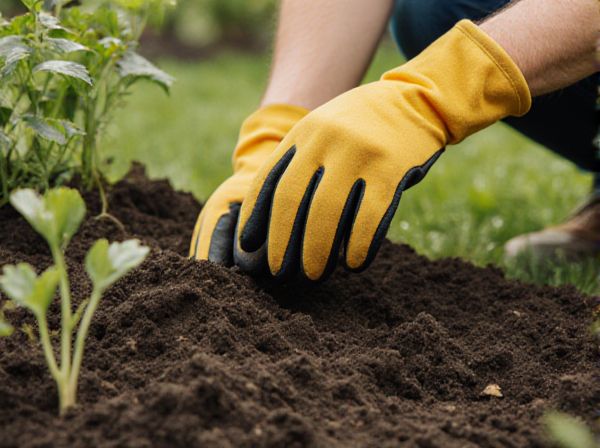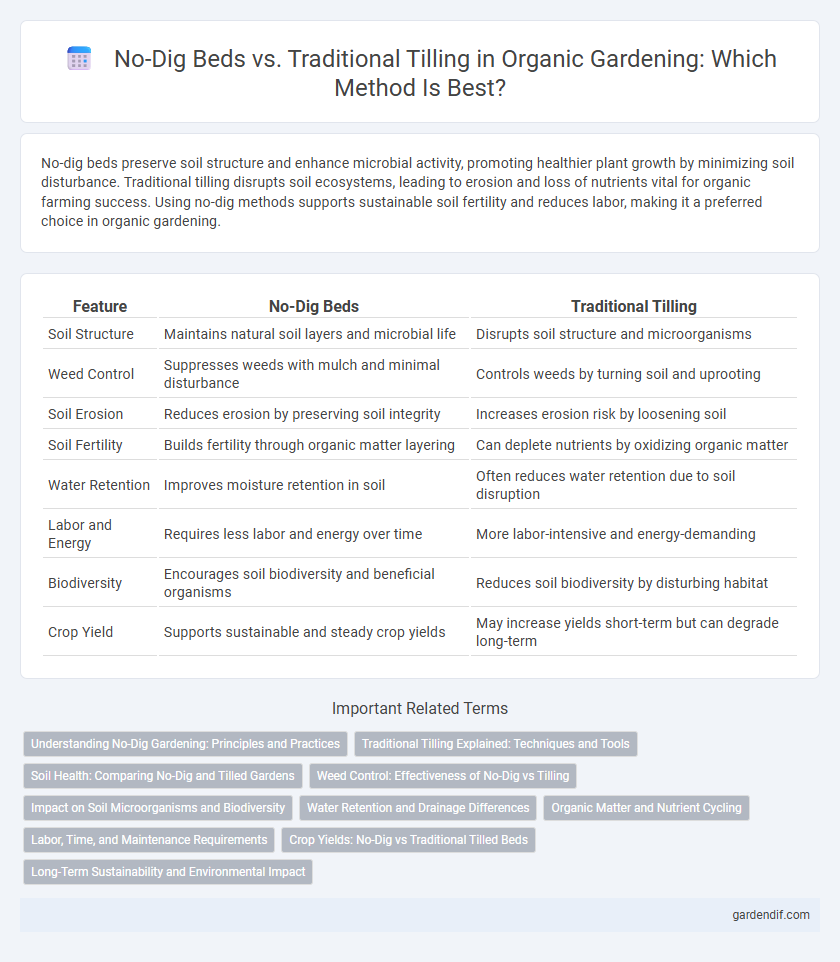
No-dig beds vs Traditional tilling Illustration
No-dig beds preserve soil structure and enhance microbial activity, promoting healthier plant growth by minimizing soil disturbance. Traditional tilling disrupts soil ecosystems, leading to erosion and loss of nutrients vital for organic farming success. Using no-dig methods supports sustainable soil fertility and reduces labor, making it a preferred choice in organic gardening.
Table of Comparison
| Feature | No-Dig Beds | Traditional Tilling |
|---|---|---|
| Soil Structure | Maintains natural soil layers and microbial life | Disrupts soil structure and microorganisms |
| Weed Control | Suppresses weeds with mulch and minimal disturbance | Controls weeds by turning soil and uprooting |
| Soil Erosion | Reduces erosion by preserving soil integrity | Increases erosion risk by loosening soil |
| Soil Fertility | Builds fertility through organic matter layering | Can deplete nutrients by oxidizing organic matter |
| Water Retention | Improves moisture retention in soil | Often reduces water retention due to soil disruption |
| Labor and Energy | Requires less labor and energy over time | More labor-intensive and energy-demanding |
| Biodiversity | Encourages soil biodiversity and beneficial organisms | Reduces soil biodiversity by disturbing habitat |
| Crop Yield | Supports sustainable and steady crop yields | May increase yields short-term but can degrade long-term |
Understanding No-Dig Gardening: Principles and Practices
No-dig gardening promotes soil health by preserving its natural structure and microbial ecosystem, reducing erosion and compaction compared to traditional tilling methods. This technique involves layering organic materials like compost and mulch directly on the soil surface to suppress weeds and enrich nutrient cycling without disturbing earthworms and beneficial organisms. Emphasizing minimal soil disturbance aligns with sustainable organic practices, improving long-term garden productivity and biodiversity.
Traditional Tilling Explained: Techniques and Tools
Traditional tilling involves mechanically turning and breaking up soil using tools such as plows, rototillers, and harrows to prepare seedbeds and control weeds. This technique enhances soil aeration and incorporates organic matter but can disrupt soil structure and microbial activity over time. Farmers rely on implements like moldboard plows and disc harrows to achieve desired soil texture and weed management in conventional agriculture.
Soil Health: Comparing No-Dig and Tilled Gardens
No-dig beds preserve soil structure by minimizing disturbance, which enhances microbial diversity and promotes beneficial organisms like earthworms. Traditional tilling disrupts soil layers, leading to increased erosion, loss of organic matter, and reduced soil fertility over time. Maintaining undisturbed soil in no-dig gardens improves moisture retention and nutrient cycling, resulting in healthier, more resilient plants.
Weed Control: Effectiveness of No-Dig vs Tilling
No-dig beds suppress weeds more effectively by maintaining a stable soil structure and preserving beneficial microorganisms that compete with weed seeds. Traditional tilling disturbs the soil, often bringing dormant weed seeds to the surface and promoting their germination. Studies show no-dig methods reduce weed emergence by up to 70% compared to conventional tilling.
Impact on Soil Microorganisms and Biodiversity
No-dig beds preserve soil structure and microbial habitats by avoiding disruption caused by traditional tilling, promoting higher biodiversity and microbial activity. This organic approach enhances beneficial fungi, bacteria, and earthworm populations, crucial for nutrient cycling and soil health. In contrast, tilling disrupts these communities, often leading to reduced soil fertility and increased vulnerability to erosion.
Water Retention and Drainage Differences
No-dig beds significantly improve water retention by maintaining soil structure and organic matter, reducing evaporation and runoff compared to traditional tilling, which disrupts soil layers and promotes quicker water loss. The improved aggregation in no-dig systems enhances drainage by creating stable pore spaces, preventing waterlogging while preserving moisture for plant roots. In contrast, tilled soils often compact over time, leading to poor infiltration and uneven water distribution, hindering crop growth and resilience.
Organic Matter and Nutrient Cycling
No-dig beds preserve soil structure and promote higher organic matter content by minimizing soil disturbance, which enhances microbial activity essential for nutrient cycling. Traditional tilling breaks down soil aggregates, leading to faster organic matter decomposition and nutrient loss through erosion and runoff. Maintaining no-dig practices supports a stable ecosystem of beneficial organisms that recycle nutrients efficiently, sustaining long-term soil fertility in organic farming.
Labor, Time, and Maintenance Requirements
No-dig beds significantly reduce labor and time compared to traditional tilling by eliminating soil turning and promoting natural soil structure. Maintenance in no-dig systems is minimal due to improved moisture retention and weed suppression, whereas traditional tilling often requires frequent re-tilling and weed management. This method supports sustainable soil health, lowering long-term labor demands and enhancing crop productivity.
Crop Yields: No-Dig vs Traditional Tilled Beds
No-dig beds consistently produce higher crop yields compared to traditional tilled beds due to improved soil structure and moisture retention. The undisturbed soil ecosystem in no-dig methods enhances microbial activity and nutrient availability critical for plant growth. Studies show yield increases of up to 20% in no-dig systems for vegetables like tomatoes and carrots versus conventional tilling.
Long-Term Sustainability and Environmental Impact
No-dig beds promote long-term soil health by preserving microbial communities and organic matter, reducing erosion and improving water retention compared to traditional tilling. Traditional tilling disrupts soil structure, accelerates carbon release, and increases vulnerability to erosion, negatively impacting environmental sustainability. Over time, no-dig methods enhance biodiversity and soil resilience, supporting sustainable organic farming practices.
No-dig beds vs Traditional tilling Infographic

 gardendif.com
gardendif.com